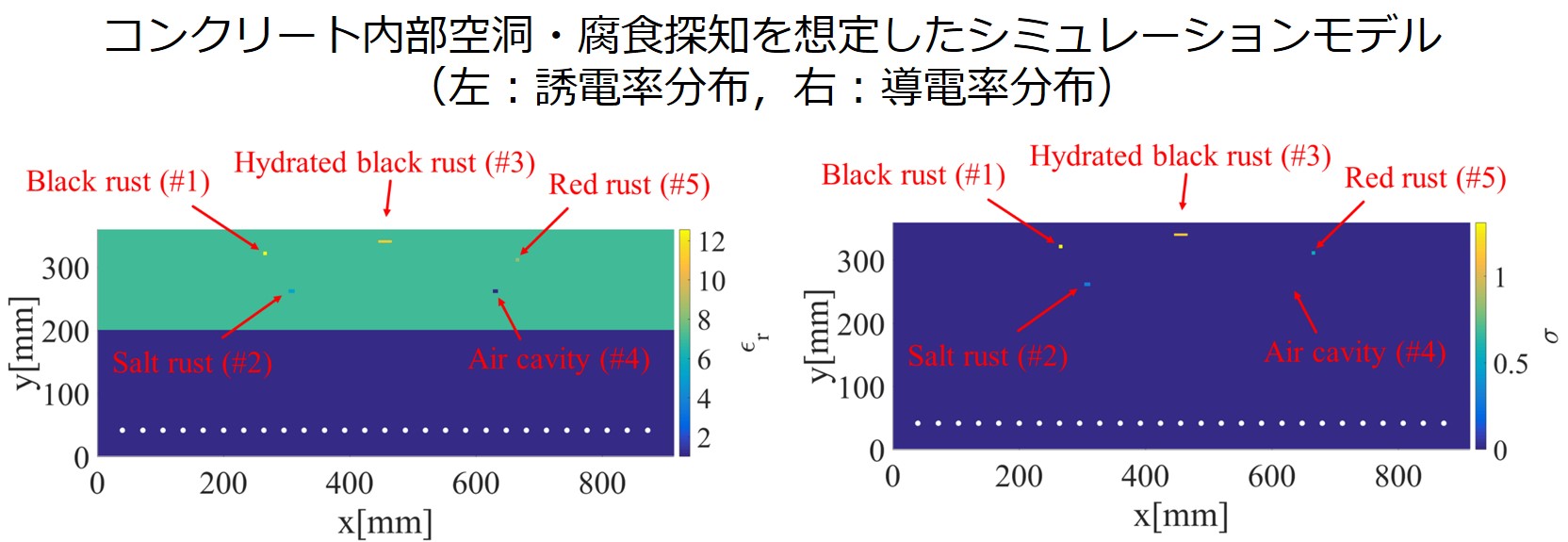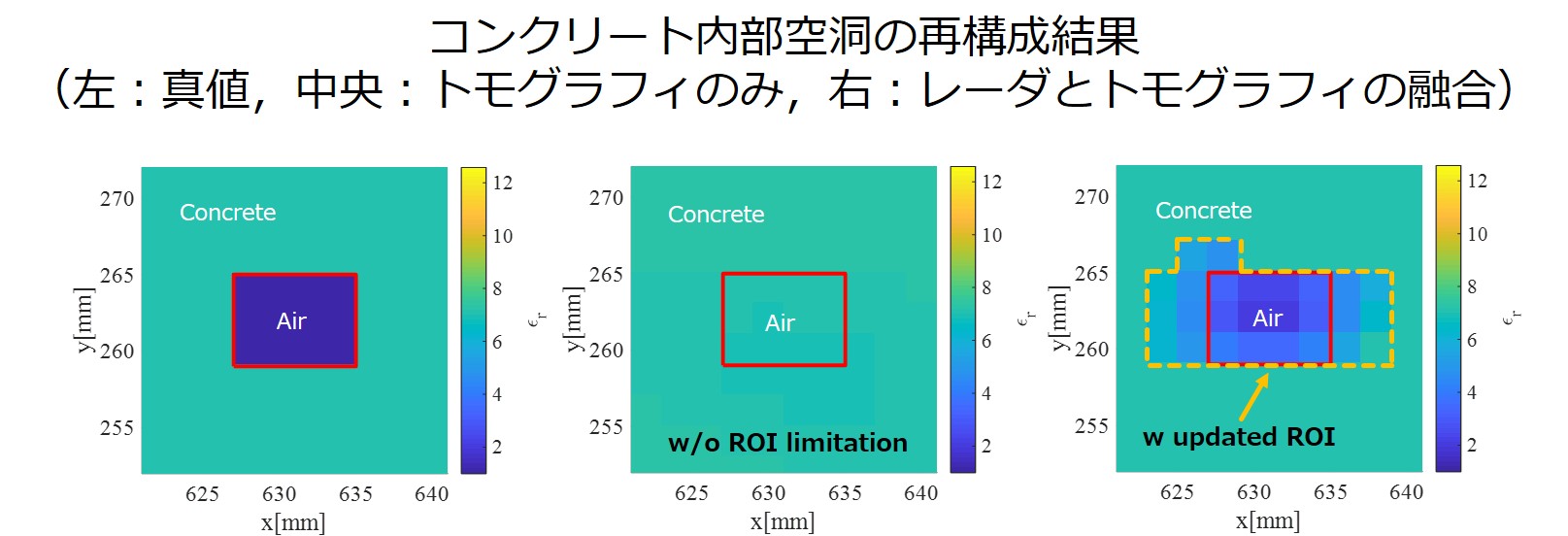Electromagnetic inverse scattering problem analysis (estimation of dielectric constant and conductivity distribution)
Research Background
Ultra-wideband (UWB) radar in the microwave band is attracting attention as a technology to solve the problems of conventional internal measurement techniques, especially in medical imaging (ultrasound: limited resolution and elastic modulus dependence of accuracy due to high-frequency attenuation, X-ray: subject exposure, MR: large equipment size and high cost, THz waves or OCT: reach depth of only a few mm). The technique is attracting attention as a solution to these problems. In particular, it is promising as a diagnostic imaging technology for early detection and treatment of breast cancer, utilizing the fact that the dielectric constant and conductivity of cancer cells are significantly different from those of normal cells. This technology is also useful for disaster prevention and recovery, such as detecting water and gas pipe ruptures after disasters and detecting cracks and corrosion on aging roads and bridges. On the other hand, the complex permittivity varies greatly depending on the type of concrete, cavity, rebar, or corroded rebar, and it is important to precisely reconstruct the complex permittivity distribution inside the object in order to accurately distinguish cancerous tissue from mammary tissue. A promising method for complex permittivity reconstruction is called inverse scattering analysis or tomography.
Problems with Conventional Tomography Methods
The inverse scattering analysis or tomography method solves an inverse problem in the area integral equation derived from the Maxwell equation, which completely describes the scattering phenomenon of electromagnetic waves, using the observed scattered electric field (also called the inverse scattering problem). As a measurement method, electromagnetic waves are irradiated from multiple directions, as in X-ray CT, and the complex permittivity distribution is reconstructed from the scattered electric field by applying an appropriate image analysis method. On the other hand, microwaves have a longer wavelength than X-rays, which causes diffraction and multiple scattering inside the microwaves, so image analysis (Radon transform, linear analysis) in CT is not applicable. In other words, the above problem is a so-called nonlinear problem, and the number of observed data is small compared to the number of unknowns (number of image pixels), which is one of the problems of poor setup.
Innovative Microwave Imaging by Fusion of Radar and Tomography
To solve these problems, we are developing a framework that organically integrates radar (SA and RPM methods) and tomography methods. Specifically, by narrowing down the region of interest (ROI) where the target (cancerous tissue, cavity, etc.) exists from the radar (RPM) image to the vicinity of the target, we can dramatically reduce the number of unknowns, and by updating the ROI region sequentially, we can achieve both highly accurate shape estimation and complex permittivity estimation in an extremely poor inverse problem. This enables both highly accurate shape estimation and complex permittivity estimation in extremely poor inverse problems (see Fig. 4). Figure X shows the result of combining the RPM method with the Distorted Born Iterative Method (DBIM), an inverse scattering analysis method. Assuming a model with a cavity in the concrete, the location, shape, and size of the object are first estimated by the RPM method, and then the ROI region is set. This reduces the number of unknowns by about 1/100. Figure X shows that, compared to the case where the ROI is not restricted, the complex permittivity reconstruction accuracy can be obtained by restricting the ROI to a level that cannot be reproduced by the conventional inverse scattering analysis method. In addition, by using the features of the tomography method to update the ROI, it is possible to estimate the location and shape of the cavity more accurately and to achieve bidirectional processing between radar and tomography.
Future Challenges
To maintain accuracy for more realistic and large-scale problems, we are considering approaches that make full use of deep learning, sparse modeling, and other techniques.


[1] Shuto Takahashi, Katsuyuki Suzuki, Takahiro Hanabusa and Shouhei Kidera
"Microwave Subsurface Imaging Method by Incorporating Radar and Tomographic Approaches",
IEEE Trans. on Antennas and Propagation, 2022.
Ultra-wideband (UWB) radar in the microwave band is attracting attention as a technology to solve the problems of conventional internal measurement techniques, especially in medical imaging (ultrasound: limited resolution and elastic modulus dependence of accuracy due to high-frequency attenuation, X-ray: subject exposure, MR: large equipment size and high cost, THz waves or OCT: reach depth of only a few mm). The technique is attracting attention as a solution to these problems. In particular, it is promising as a diagnostic imaging technology for early detection and treatment of breast cancer, utilizing the fact that the dielectric constant and conductivity of cancer cells are significantly different from those of normal cells. This technology is also useful for disaster prevention and recovery, such as detecting water and gas pipe ruptures after disasters and detecting cracks and corrosion on aging roads and bridges. On the other hand, the complex permittivity varies greatly depending on the type of concrete, cavity, rebar, or corroded rebar, and it is important to precisely reconstruct the complex permittivity distribution inside the object in order to accurately distinguish cancerous tissue from mammary tissue. A promising method for complex permittivity reconstruction is called inverse scattering analysis or tomography.
Problems with Conventional Tomography Methods
The inverse scattering analysis or tomography method solves an inverse problem in the area integral equation derived from the Maxwell equation, which completely describes the scattering phenomenon of electromagnetic waves, using the observed scattered electric field (also called the inverse scattering problem). As a measurement method, electromagnetic waves are irradiated from multiple directions, as in X-ray CT, and the complex permittivity distribution is reconstructed from the scattered electric field by applying an appropriate image analysis method. On the other hand, microwaves have a longer wavelength than X-rays, which causes diffraction and multiple scattering inside the microwaves, so image analysis (Radon transform, linear analysis) in CT is not applicable. In other words, the above problem is a so-called nonlinear problem, and the number of observed data is small compared to the number of unknowns (number of image pixels), which is one of the problems of poor setup.
Innovative Microwave Imaging by Fusion of Radar and Tomography
To solve these problems, we are developing a framework that organically integrates radar (SA and RPM methods) and tomography methods. Specifically, by narrowing down the region of interest (ROI) where the target (cancerous tissue, cavity, etc.) exists from the radar (RPM) image to the vicinity of the target, we can dramatically reduce the number of unknowns, and by updating the ROI region sequentially, we can achieve both highly accurate shape estimation and complex permittivity estimation in an extremely poor inverse problem. This enables both highly accurate shape estimation and complex permittivity estimation in extremely poor inverse problems (see Fig. 4). Figure X shows the result of combining the RPM method with the Distorted Born Iterative Method (DBIM), an inverse scattering analysis method. Assuming a model with a cavity in the concrete, the location, shape, and size of the object are first estimated by the RPM method, and then the ROI region is set. This reduces the number of unknowns by about 1/100. Figure X shows that, compared to the case where the ROI is not restricted, the complex permittivity reconstruction accuracy can be obtained by restricting the ROI to a level that cannot be reproduced by the conventional inverse scattering analysis method. In addition, by using the features of the tomography method to update the ROI, it is possible to estimate the location and shape of the cavity more accurately and to achieve bidirectional processing between radar and tomography.
Future Challenges
To maintain accuracy for more realistic and large-scale problems, we are considering approaches that make full use of deep learning, sparse modeling, and other techniques.
Figure 1: Simulation model for NDT measurement (Left: Permittivity, Right: Conductivity)

Figure 2: Reconstruction results (Left: Ground truth, Center: Reconstruction w/o ROI limitation, Right: Reconstruction w/ ROI limitation)

